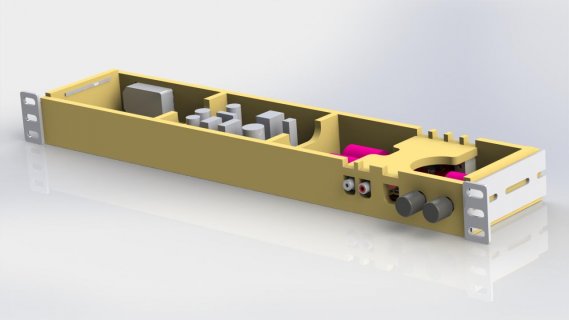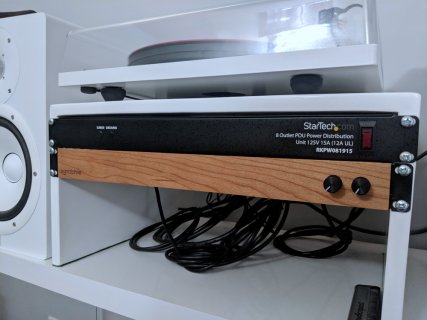I decided I wanted to build a mixer where the signal paths are entirely analog but all of the control is digital so that I could use less expensive trim pots and still get really good linearity and noise performance... I am about to submit the design to PCB.ng for fab but thought I would share the design here to see if anyone had any last minute advice before I commit.

My plan is to use sockets underneath all the expensive components to save on cost. In principle this means I could also use the PGA2311 or try different op-amps (I'm planning to use the OPA2134). All of the filters can be optionally bridged out across pairs of 0.1" headers, which also provides nice testpoints for measuring performance. I basically just copied the filter designs from Mark Hennessy's pre-amp (http://www.markhennessy.co.uk/preamp/). I specified 0.5% precision SMD components so hopefully that will be sufficient for matching purposes. The capacitors are all 25V+ rated so that the boards could be used with +/-15V analog supply, but I'm planning to use a MeanWell PD2505 +/-5 volt supply since I don't think I need so much gain (and the PGA2310 has better noise performance). I found some decent pots (TT P260) and some slick knobs (kilo OEJ series). I'm going to hang some monster 5mF electrolytic caps on the supply inputs off the edge of the board for good measure.
I don't have a great place to go for sheet metal prototyping (protocase is ok but expensive) so I will be laser cutting the enclosures from MDF and paneling the exterior with hardwood:


The teensy will forever measure the pot voltages and occasionally set the pga2310 output levels. I'm expecting some IIR filters with a few second time constant to be sufficient. The "fade" control pot will pan between the rear input and the front input, and the second knob will control volume.
I'd be grateful for feedback, especially if you spot anything problematic in the circuit. Since the minimum order is 6 boards on the pcb.ng run, I'll also have five extra pcbs if anyone is interested.
- Robb

My plan is to use sockets underneath all the expensive components to save on cost. In principle this means I could also use the PGA2311 or try different op-amps (I'm planning to use the OPA2134). All of the filters can be optionally bridged out across pairs of 0.1" headers, which also provides nice testpoints for measuring performance. I basically just copied the filter designs from Mark Hennessy's pre-amp (http://www.markhennessy.co.uk/preamp/). I specified 0.5% precision SMD components so hopefully that will be sufficient for matching purposes. The capacitors are all 25V+ rated so that the boards could be used with +/-15V analog supply, but I'm planning to use a MeanWell PD2505 +/-5 volt supply since I don't think I need so much gain (and the PGA2310 has better noise performance). I found some decent pots (TT P260) and some slick knobs (kilo OEJ series). I'm going to hang some monster 5mF electrolytic caps on the supply inputs off the edge of the board for good measure.
I don't have a great place to go for sheet metal prototyping (protocase is ok but expensive) so I will be laser cutting the enclosures from MDF and paneling the exterior with hardwood:


The teensy will forever measure the pot voltages and occasionally set the pga2310 output levels. I'm expecting some IIR filters with a few second time constant to be sufficient. The "fade" control pot will pan between the rear input and the front input, and the second knob will control volume.
I'd be grateful for feedback, especially if you spot anything problematic in the circuit. Since the minimum order is 6 boards on the pcb.ng run, I'll also have five extra pcbs if anyone is interested.
- Robb



